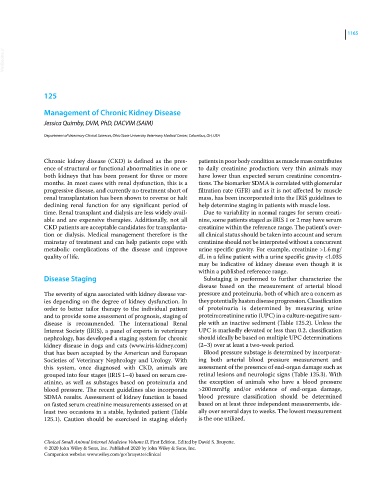Page 1227 - Clinical Small Animal Internal Medicine
P. 1227
1165
VetBooks.ir
125
Management of Chronic Kidney Disease
Jessica Quimby, DVM, PhD, DACVIM (SAIM)
Department of Veterinary Clinical Sciences, Ohio State University Veterinary Medical Center, Columbus, OH, USA
Chronic kidney disease (CKD) is defined as the pres- patients in poor body condition as muscle mass contributes
ence of structural or functional abnormalities in one or to daily creatinine production; very thin animals may
both kidneys that has been present for three or more have lower than expected serum creatinine concentra-
months. In most cases with renal dysfunction, this is a tions. The biomarker SDMA is correlated with glomerular
progressive disease, and currently no treatment short of filtration rate (GFR) and as it is not affected by muscle
renal transplantation has been shown to reverse or halt mass, has been incorporated into the IRIS guidelines to
declining renal function for any significant period of help determine staging in patients with muscle loss.
time. Renal transplant and dialysis are less widely avail- Due to variability in normal ranges for serum creati-
able and are expensive therapies. Additionally, not all nine, some patients staged as IRIS 1 or 2 may have serum
CKD patients are acceptable candidates for transplanta- creatinine within the reference range. The patient’s over-
tion or dialysis. Medical management therefore is the all clinical status should be taken into account and serum
mainstay of treatment and can help patients cope with creatinine should not be interpreted without a concurrent
metabolic complications of the disease and improve urine specific gravity. For example, creatinine >1.6 mg/
quality of life. dL in a feline patient with a urine specific gravity <1.035
may be indicative of kidney disease even though it is
within a published reference range.
Disease Staging Substaging is performed to further characterize the
disease based on the measurement of arterial blood
The severity of signs associated with kidney disease var- pressure and proteinuria, both of which are a concern as
ies depending on the degree of kidney dysfunction. In they potentially hasten disease progression. Classification
order to better tailor therapy to the individual patient of proteinuria is determined by measuring urine
and to provide some assessment of prognosis, staging of protein:creatinine ratio (UPC) in a culture‐negative sam-
disease is recommended. The International Renal ple with an inactive sediment (Table 125.2). Unless the
Interest Society (IRIS), a panel of experts in veterinary UPC is markedly elevated or less than 0.2, classification
nephrology, has developed a staging system for chronic should ideally be based on multiple UPC determinations
kidney disease in dogs and cats (www.iris‐kidney.com) (2–3) over at least a two‐week period.
that has been accepted by the American and European Blood pressure substage is determined by incorporat-
Societies of Veterinary Nephrology and Urology. With ing both arterial blood pressure measurement and
this system, once diagnosed with CKD, animals are assessment of the presence of end‐organ damage such as
grouped into four stages (IRIS 1–4) based on serum cre- retinal lesions and neurologic signs (Table 125.3). With
atinine, as well as substages based on proteinuria and the exception of animals who have a blood pressure
blood pressure. The recent guidelines also incorporate >200 mmHg and/or evidence of end‐organ damage,
SDMA results. Assessment of kidney function is based blood pressure classification should be determined
on fasted serum creatinine measurements assessed on at based on at least three independent measurements, ide-
least two occasions in a stable, hydrated patient (Table ally over several days to weeks. The lowest measurement
125.1). Caution should be exercised in staging elderly is the one utilized.
Clinical Small Animal Internal Medicine Volume II, First Edition. Edited by David S. Bruyette.
© 2020 John Wiley & Sons, Inc. Published 2020 by John Wiley & Sons, Inc.
Companion website: www.wiley.com/go/bruyette/clinical

